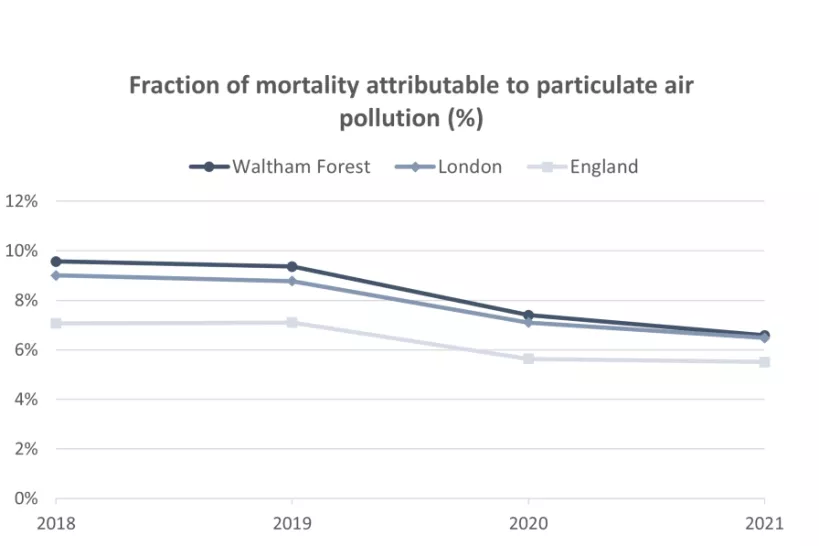Last updated: 12 June 2024
Next review: 12 December 2024
This content is part of the Waltham Forest JSNA. To see other JSNA content, visit the JSNA landing page
Air pollution can contribute to cardiovascular and respiratory conditions and shorten lives. It is estimated that long-term exposure to air pollution in the UK has an annual cumulative effect equivalent to 28,000 to 36,000 deaths. The highest air pollution exposure is found in deprived urban environments and will therefore be contributing to health inequalities.
There was less traffic on roads during the COVID-19 pandemic, which had a positive impact on the air pollution levels across London [1]. Waltham Forest also experienced improvement in air pollution during the pandemic as measured through the annual concentration of fine particulate matter (PM2.5). PM2.5 are tiny particles smaller than 2.5 micrometres in diameter from sources such as industrial processes, wood burning, tyre and brake wear, which can travel into the lungs and cause a range of respiratory symptoms.
In 2020, Waltham Forest ranked 12th highest for levels of PM2.5 out of 33 London boroughs and had one of the highest levels among the outer London boroughs. The concentration of the fine particulate matter in Waltham Forest in 2020 was measured as 10.0µg/m3 (micrograms per cubic metre), down from 12.8µg/m3 in 2019, but remaining higher than the England average of 7.5µg/m3 and the London rate of 9.6µg/m3 [2].
In 2021, 6.6% of the annual deaths from all causes in those aged 30 and over in Waltham Forest were attributable to particulate air pollution; a proportion similar to the London average (6.5%) but higher than the England average (5.5%). This is a further decline from 2020 figure (7.4%) and notably lower from the pre-pandemic level at 9.4% in 2019.
Note that air pollution levels but also mortality was significantly impacted by the pandemic and therefore, the data and trends from this period should be interpreted with caution.

Source: OHID Public Health Outcomes Framework. Date accessed: 24 April 2023
References:
[1] Public Health England (2021). Health Profile for England 2021. Date accessed: 24 April 2023.
[2] Office for Health Improvement and Disparities. Public Health Profiles: Health Protection. Date accessed: 28 April 2023.